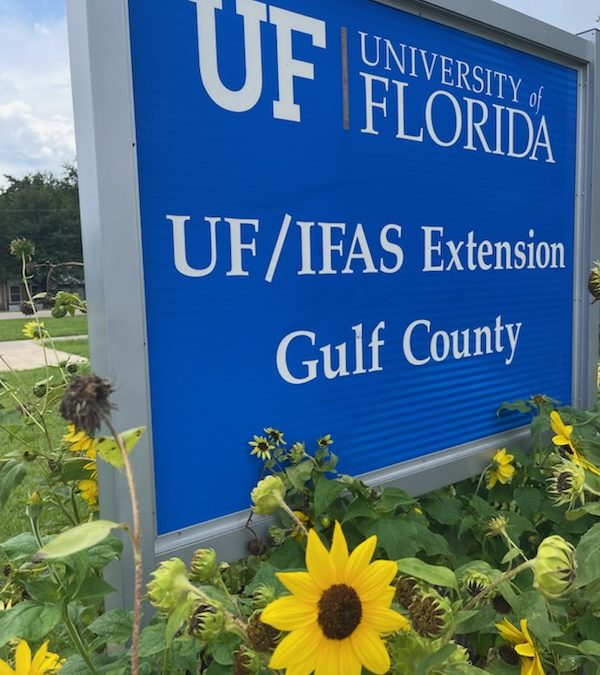
by Ray Bodrey | Jul 20, 2025
Sunflowers, Helianthus spp., are a great choice for gardeners who are looking for some cheerful color in their landscape. Here in Florida, we have the main ingredient for success, lots of sunshine!

Skyscraper Sunflower. Credit: Ray Bodrey, UF/IFAS Extension.
Sunflowers are short-lived annuals. A good average time between planting and bloom is roughly 65 days. You can typically plant sunflowers in Florida beginning in late winter until early fall. Only the coldest months are the issue, and for most years that’s only a couple of months for us. Sunflowers can be planted almost anywhere there is full sun. The major selling point to plant sunflowers is of course the impressive blooms (figure 1). These yellow to sometimes orange or red petaled flowers develop a central seed disc, with most varieties having approximately an 8” diameter in growth.
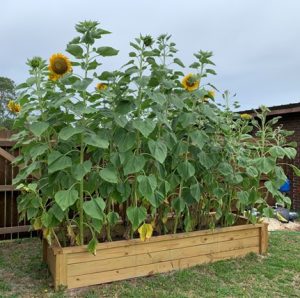
Skyscraper sunflowers planted in close pattern. Credit: Ray Bodrey, UF/IFAS Extension.
As for planting, you may choose to plant narrow rows and close seed spacing in order to cull less preforming plants later. A final row and seed spacing of 2’-3’ is recommended for full height and development of most varieties. However, you may choose to plant in a bed, using a close pattern as seen in figure 2. In any event, sunflowers are easy to propagate by seed and are very low maintenance. However, powdery mildew and spittle bugs can be a nuisance. A general garden fungicide and insecticide will help if problems occur.
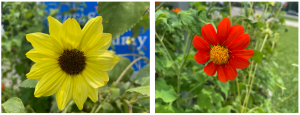
Sunflowers, Helianthus spp. Credit: Ray Bodrey, UF/IFAS Extension.
Sunflowers are available in many varieties, which consists of different color blooms and plant sizes. These sizes range from dwarf (1’-3’) to tall (10’-15’) varieties (figure 2). You may wish to stake taller varieties at some point, as some plants will tend to lean with no wind break in place. Here’s a few gardening variety common names to look for: sunbright, sonja, sunrich lemon or orange and autumn beauty. Seed companies also have mixes available in packets. For tall plants, mammoth or skyscraper varieties exist.
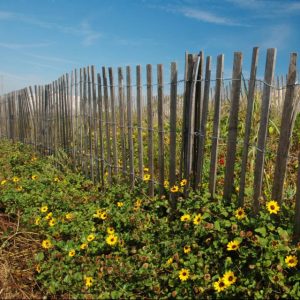
Beach sunflower. Credit: Ralph Mitchell, UF/IFAS Extension.
If you are fond of the sunflower bloom and looking for a groundcover, there are a couple of native perennials that fit this category. Beach sunflower, Helianthus debilis or swamp sunflower, Helianthus angustifolius, are groundcovers/ornamentals for landscapes and thrive in dry, hot climates and in a range of soil types. They also are great pollinator attractors.
For more information, contact your local county extension office. Happy Gardening!
Supporting information for this article and links to other publications can be found at the UF/IFAS Gardening Solutions website: https://gardeningsolutions.ifas.ufl.edu/plants/ornamentals/sunflowers.html
UF/IFAS Extension is an Equal Opportunity Institution.
by Danielle S. Williams | Jul 20, 2025
Black-eyed Susan, Rudbeckia hirta, is a yellow wildflower commonly found throughout Florida. It is easily recognized by its golden yellow petals and dark brown center or its signature “black eye”. Not only is black-eyed Susan a beautiful addition to any landscape or garden, but it is also beneficial to pollinators and easy to care for! A win, win for gardeners alike!
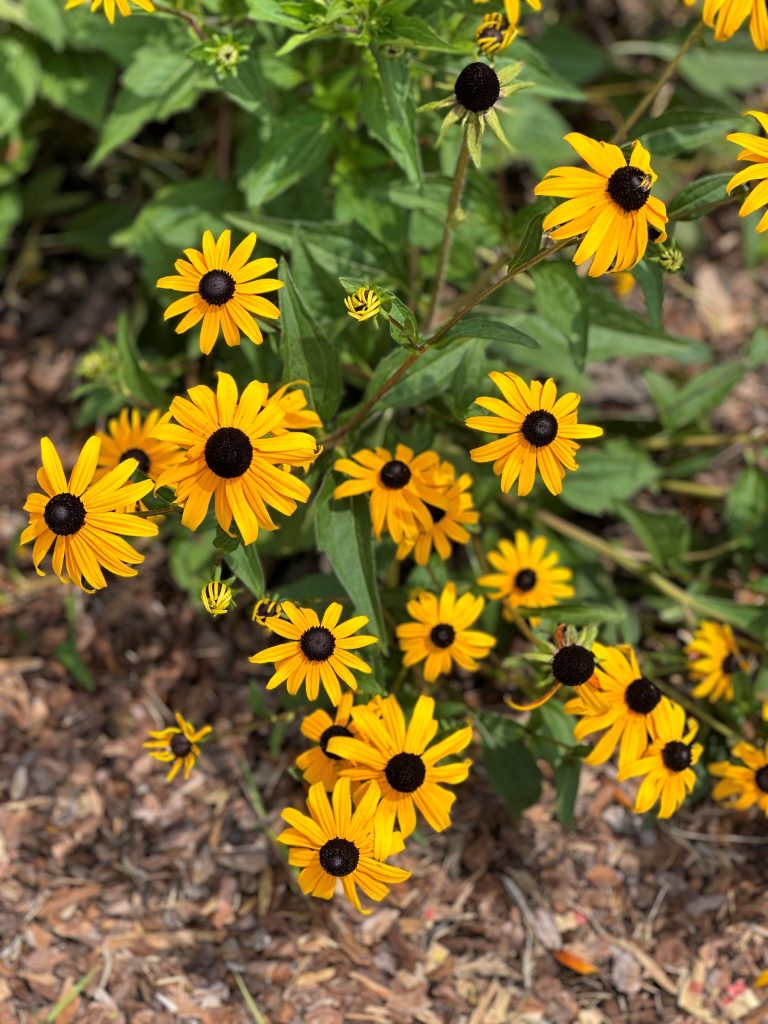
As a native wildflower to much of the eastern and central United States, Black-eyed Susan plays an important role in supporting local ecosystems. It provides pollen and nectar to a wide variety of pollinators such as native bees, butterflies, hoverflies, and other beneficial insects. Its long blooming season provides a food source to support these species during the hot summer months when many other plants are not blooming.
One of the greatest appeals of Black-eyed Susan is its versatility. It can be grown in full sun and well-drained soil but will tolerate poor soil, drought and even some shade. After establishment, it requires minimal care and returns each year.
Growing Considerations:
- USDA Hardiness Zones 2-11
- Soil pH range: 6.0-7.2
- Soil tolerances: clay; sand; acidic; loam
- Plant spacing: 12 – 28 inches
- Moderate drought tolerance
- Flowering months: May – October
- Growth height: 1-3 feet
If you’re looking for a resilient, beautiful, pollinator-friendly flower that brings bold color during the summer and is easy to care for, Black-eyed Susan is a great option!
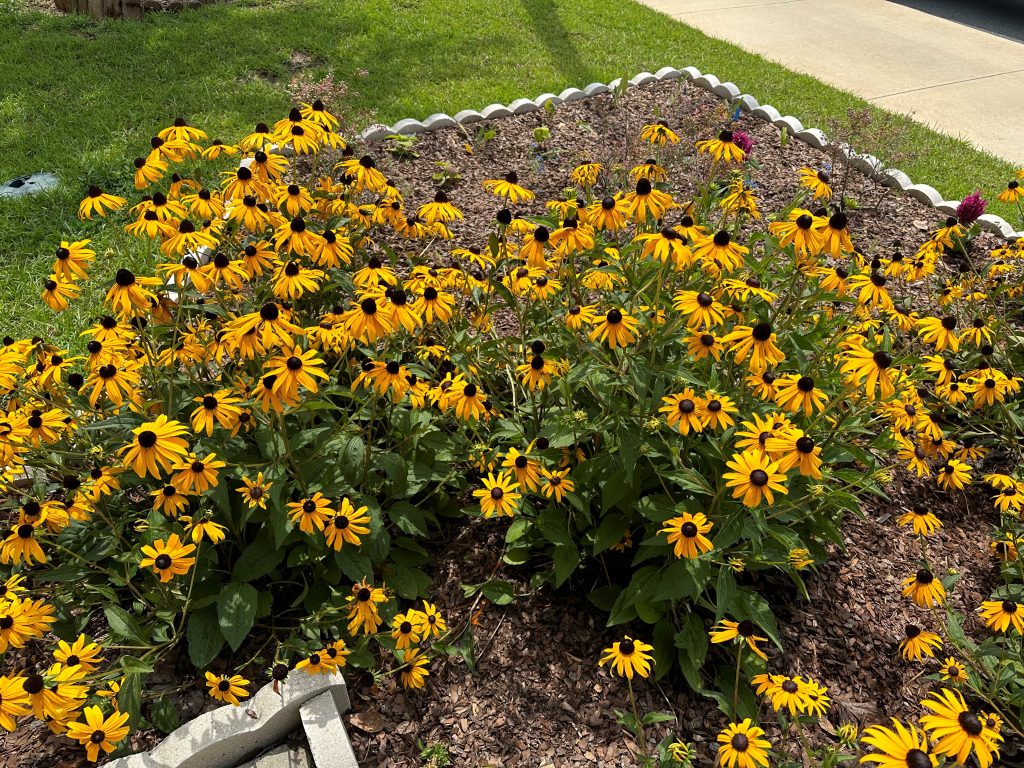
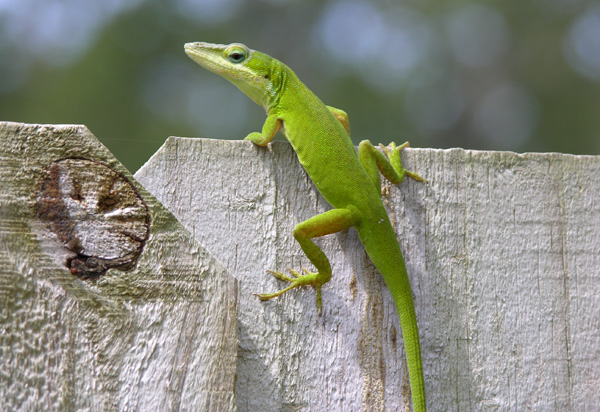
by Carrie Stevenson | Jul 11, 2025
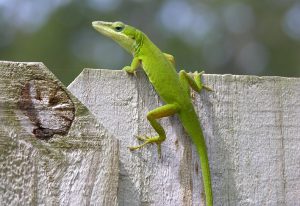
Green anole on a fence post. Photo credit: Dr. Steve A. Johnson, UF
There’s plenty of animals you might call “cute”, but lizards usually aren’t among them. However, I’d take exception to that premise when discussing the green anole (Anolis carolinensis). With big blue eyes, brilliant green skin, and flirty males doing push-ups and flexing their dewlaps (the pink throat fan) at you, these little reptiles are more endearing than most.
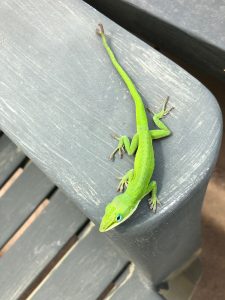
A green anole–with a slightly forked tail–poses on a deck chair. Photo credit: Carrie Stevenson, UF IFAS Extension
Native to Florida and the deep South, they are competent crawlers, prowlers, and predators. I see them frequently on my office building’s outer stucco walls, running along fences, or skittering up trees. They feed on beetles, termites, ants, worms, spiders, and more. Called the “American chameleon” by some, they possess excellent camouflage, changing their skin rapidly from green to dull brown depending on their backgrounds.
Over the last few years, I—and many biologists—have been concerned about the health of their population. As the invasive Cuban brown anole successfully gained a foothold in north Florida, I saw fewer green anoles and many more of the browns. It has seemed that the greens were losing ground. The invasive species can outcompete the native by eating the green anoles’ young and eggs.
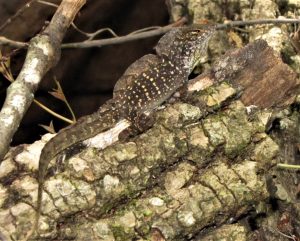
Male brown anole on a tree. Photo credit: Dr. Steve A. Johnson, UF
A recent study by a UF PhD candidate found another explanation for why Floridians have seen more brown anoles than green. His study found that the two species have found a way to coexist—the green anoles are moving further up the canopy (an average of 17x higher!), while browns are staying closer to ground level. The green anoles thrive in more natural areas, whereas the brown anoles do well in lower level urban surroundings.
Interestingly, this summer I’ve noticed a resurgence in green anoles and have rarely seen brown ones. I am wondering if our snow days knocked the tropical brown anole populations back, enabling the more temperate greens to recover. Time will tell if the greens have regained their advantage or if it’s only temporary.
One of the best ways to help improve green anole populations is to plant more native vegetation, especially multiple layers, to create a varied canopy. For more information on how to do that, check out our Florida-Friendly Landscaping Guide to Plant Selection and Landscape Design.
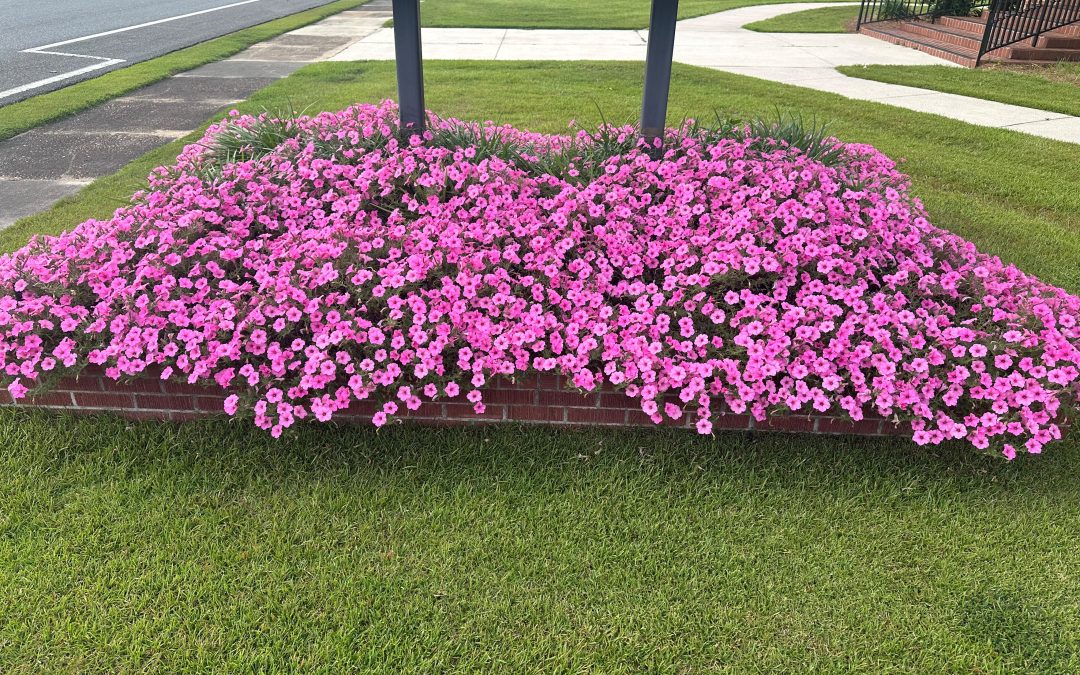
by Daniel J. Leonard | Jul 11, 2025
Normally, when one thinks of flowers that can take Florida’s summer heat, Petunia isn’t the first species that comes to mind, certainly not for me. For our northern neighbors, Petunias are one of the most popular summer bedding plants; their warm days and cool summer nights are perfect for Petunias. But, in the deep south, we are forced to grow Petunias in the cool months before the summer heat melts them. However, with the introduction of Wave Petunias back in 1995, the idea of a heat tolerant hybrid Petunia that could extend flowering was born. Then a decade later in 2006, Proven Winners debuted the next evolution of heat tolerant Petunias came along, the ultra-tough Supertunia Series, and disrupted everything we thought we knew about growing Petunias.
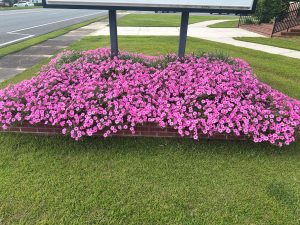
Supertunia Vista® Bubblegum® in mid-June 2025. Photo courtesy of Daniel Leonard.
There are several sub-series of Supertunia, all are good in my experience, but my favorite and the most resilient to heat is definitely the Vista® series, specifically the cultivar Vista® Bubblegum®. Vista® Bubblegum® is a massively growing Petunia that can spread in excess of 4’ and possesses vivid pink flowers with dark pink veins. Adding to the appeal of Vista Bubblegum is its self-cleaning nature, meaning no deadheading is required and it will flower more or less continuously throughout the life of the plant. However, the most outstanding aspect of the plant is its heat tolerance (for a Petunia). In general, Petunias in the Panhandle are planted in the fall, grow through the *usually* mild winter months, flower in the spring and then begin to languish in the heat of May-June. Vista® Bubblegum® chooses instead to laugh at the heat and mine (planted in early November) are still going strong, unfazed by the heat, in the second week of a very hot July. This plant just won’t quit. Pretty impressive stuff.

Supertunia Vista® Bubblegum® beginning to look a little tired in mid-July 2025 but still going strong! Photo courtesy of Daniel Leonard.
For best results with Vista® Bubblegum® and all other petunias, be sure to site in a location with full sun and keep regularly watered and fertilized, especially if grown in containers, as these prolific bloomers require a lot of energy to support the months-long flower show. Unfortunately, unless you already have Vista® Bubblegum® in your garden, you’ll have to wait until the fall to find more in nurseries, but these plants and its series siblings are well worth the wait! Plant a few this fall and enjoy beautiful color throughout next spring and summer.
For more information on growing petunias or any other horticultural topic, contact your local UF/IFAS Extension County office. Happy gardening!
by Joshua Criss | Jul 6, 2025
The Panhandle has experienced a significant amount of rain lately. It seems like there isn’t a day that goes by in which even walking out the door seems impossible due to the downpour. While this is hard enough for the people living in the area, without a mitigation strategy, your lawn and landscapes may be suffering just as much. The good news is that there are several methodologies to usher the excess into local surface water reservoirs.
The Issue
Before we get started, let’s first talk about why storm water needs to be managed. Storm water can be defined as any rainfall failing to infiltrate the soil. In short, it is water that flows from your property onto impervious ground into storm water drains and ultimately into the Gulf of America.
This water can and will carry pollution from houses, pet waste, and heavy metals, amongst other things, into our local waters. All of that is before we even account for nitrogen moving from the atmosphere during these storms. All of this may be detrimental to local aquatic populations, ultimately leading to eutrophication due to excess nutrients. In the worst cases, these nutrient-rich waters cause red tide, which limits recreational use and fishing in our area.
The good news is that homeowners can take specific actions to mitigate the risks associated with storm water. The three primary types of these are rain gardens, swales, and rain barrel catchment systems.
Rain Gardens
A rain garden is an area planted with vegetation designed to prevent mass water flow on your property. They may be sited in multiple locations, including sloped yard areas, or those in which you notice pooling following a rain event.
Carve out the area and backfill with porous soil materials. The plants you’ll want to select for this garden should be able to tolerate drought followed by periods of flooding. One solid strategy for this mitigation system is to direct the downspouts from your house into one of these garden spaces. Between the turfgrasses planted along the water’s path and the root systems of the plants within the rain garden, storm water will be pushed through a biofiltration system while being redirected from the local watershed. To learn more about rain gardens, consult these document.

UF/IFAS Photo: Theresa Watkins
Swales
Swales are like rain gardens in that their primary purpose is to redirect water flow. While these may be outfitted with vegetative plantings termed bioswales, the highway for water flow in traditional swales typically consists of turfgrasses.
These are quickly draining soils, aided further by the thick root masses inherent to grass. Where they differ from rain gardens is in the amount of work they require. Critical to this system is selecting turfgrass species suitable for the site and applying the correct water, fertilizer, and mowing practices. These practices allow for strong and stress-free grass growth.
Rain Barrels
Last, though certainly not least, are rain barrels. These may be found at the downspout of gutter systems attached to houses. Their purpose is to collect the stormwater flowing from the roof. They can be a handy tool in eliminating stormwater runoff. To learn more about designing rain barrel catchment, consult this document.

UF/IFAS Photo
Stormwater is a significant concern in our lawns and landscapes. If allowed to go unchecked, it provides an avenue for pollutants and excessive nutrients to enter our waterways. Implementing the strategies in this article can significantly reduce these risks. For more information on stormwater management or any horticulture topic, refer to your local Extension office.
















